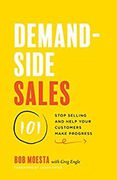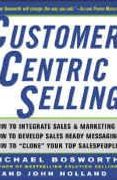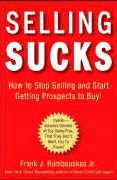
A 5 Minute Overview Of
Demand-Side Sales 101
Stop Selling and Help Your Customers Make Progress
About the Authors
Bob Moesta is a co-founder of The Re-Wired Group, and one of the architects of the Jobs to be Done theory in conjunction with the late Harvard Business School professor Clayton Christensen (1952 - 2020). He has launched more than 3,500 new products and services, and founded seven start-ups throughout his career. Bob Moesta trained as an engineer and worked as an intern for Dr. W. Edwards Deming, the father of the quality revolution. He is a graduate of Michigan State University, Harvard Business School, and Stanford University.
Greg Engle is also a co-founder of The Re-Wired Group, and currently serves as a partner in the firm. He is a skilled teacher, consultant, and coach, and has been a sales manager for several companies as well as director of sales for a senior living community. Greg Engle is a graduate of Macomb Community College.
The Main Idea
Most companies approach sales solely from the supply side of the equation — "We've made a great product, now let's go find some customers". A different and potentially better way to sell is to cater to the demand side of the equation instead — "What problem is my customer trying to solve right now, and how can I get them to pull my product or service into their life and/or career?"

Demand-side selling is where you sell by helping people make progress in the journey they are on. You reframe the sales process to be more like coaching, mentoring, and helping rather than pushing what you have. Help customers hire your product to enable them to get a job done they care about.
Don't push products. Create pull by focusing on what customers are struggling with, and what they are trying to achieve. That's a better and smarter way to sell.
Great salespeople don't sell; they help. They listen, understand what you want to achieve, and help you achieve it. A better title would be "concierge." Great salespeople help customers make progress in their lives, on their terms. They are helpful, empowering, curious, and creative. They create win-win situations! Salespeople are the lifeblood of any organization. Let us teach you how to stop selling and start helping people make progress in their lives.
How to Help Your Customers Make Progress
1. Selling vs. Buying. Traditional sales is supply-side thinking — you talk extensively about features, benefits, and use persuasion. Demand-side selling is where you get to understand what buyers and users are trying to achieve first. You identify when they have a struggling moment and think, "Maybe I can do better." You align your product with the job to be done (JTBD).
2. The three key frameworks for how people buy. To excel at demand-side selling, you need to understand three frameworks:
- The three sources of buyer energy and motivation
- The four forces of progress
- The JTBD timeline
3. Applying the demand-side frameworks. To figure out how to move from pushing products and services to creating consistent demand-side pull, you need to start interviewing your existing customers, and see the world through their eyes. Identify the JTBD when people consider, and ultimately buy your product or service. Fill in details for the three key frameworks, and find the set of causes which will generate a domino effect. Connect the dots and then reframe your selling process as serving and helping the customer get jobs done. It's a better way to sell.
Key Takeaways
Don't push products. Create pull by focusing on what customers are trying to do, and helping them.
Everyone’s struggling with something, and that’s where the opportunity lies to help people make progress. Selling isn’t about you. Great sales requires a complete devotion to being curious about other people. Their reasons, not your reasons.
Demand-side sales is about pulling people toward progress. Flipping this lens flips the role of salesperson from icky used car salesperson to a helper. When you get away from pushing your product, you start to make people feel like you’re helping them; you’re their concierge. You’re no longer the used car salesperson. A great salesperson listens first and then helps.
Summaries.Com Editor's Comments
Now this is a very smart book. Bob Moesta and Greg Engle make the point that most companies approach sales from the Supply side: "We've made a great product. Let's go find someone to sell it to". They point out a much better way to sell is to use a Demand side perspective: " Here's a group of customers who are trying to solve this problem. How can we help them, and get them to pull our product or service into their life and/or career?"
Demand-side selling is all about understanding the job customers want done, and then helping them make progress on their journey. It's the opposite of being pushy. You create pull instead. Or, in their words: "Great salespeople don't sell; they help. Great salespeople help customers make progress in their lives. They create win-win situations."
Very smart, and very much aligned with the digital world in which we now operate. Stop selling, and start helping people make progress. It works.
Want in-depth 30-minute summaries?
In addition to this 5-minute overview, Summaries.Com has a premium 30-minute summary of this book and 1,000+ more, to help you advance your career and business.
Check Out Summaries.com Premium Plans Today!Want more 5-minute Snapshots?
To get a new 5-minute business book snapshot each week, sign up for the Summaries.com free plan.
Sign Up for the Summaries.com Free PlanSales Strategies 101 Collection
If you enjoyed this summary, here is a collection of related business book summaries, to help you get ideas and strategies that will give you an edge over your competition.
This mini-course will help you sell better because you sell smarter.
Buy Sales Strategies 101 Collection (5 x 30-Min Summaries)
Demand-Side Sales 101
Stop Selling and Help Your Customers Make Progress
by Bob Moesta and Greg Engle

Fire Your Sales Team Today
Then Rehire Them as Sales Guides in Your New Revenue Department
by Erich Keiles and Mike Lieberman

Customer-Centric Selling
The Message Driven Sales Process
by Michael Bosworth and John Holland

Selling Sucks
How to Stop Selling and Start Getting Prospects to Buy!
by Frank Rumbauskas Jr.

Selling the Dream
How to Promote Your Product, Company or Ideas Using Everyday Evangelism
by Guy Kawasaki